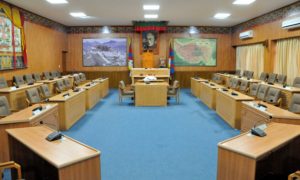
Tibetan Parliament in Exile in McLeod Ganj, India (Photo by Don Knebel)
In 1950, 15-year-old Tenzin Gyatso became the 14th Dalai Lama, making him the temporal leader of Tibet. In 1959, during a failed revolt against Chinese control, the Dalai Lama and a small entourage escaped to India, where the Indian government allowed them to establish a Tibetan government in exile in McLeod Ganj, a former British military town in the mountains of northwest India. Thousands of Tibetan refugees, often traveling by foot through Nepal, joined the Dalai Lama in McLeod Ganj, now known as “Little Lhasa.”
While still in Tibet, the Dalai Lama had advocated that Tibetans become self-governing. In 1960 he formed the Tibetan Parliament in Exile, with its home in McLeod Ganj and its members elected by refugees from the three traditional provinces of Tibet and from the four schools of Tibetan Buddhism. In 2011, the Dalai Lama formally relinquished any role in the exile government, leaving control entirely to the elected representatives.
The single chamber Tibetan Parliament in Exile is the legislative branch of the Central Tibet Administration. Although claiming authority over the entire lands and people of Tibet, the exile government focuses most of its attention on the needs of the approximately 125,000 Tibetan exiles, 100,000 of them in India, who pay voluntary taxes and receive in exchange a green book similar to a passport. Holders of the green book can then receive health, education and similar services provided by the Central Tibet Administration. In 2014, the Tibetan Parliament in Exile, with between 43 and 47 members, moved into a newly refurbished home in McLeod Ganj featuring a large portrait of the Dalai Lama.